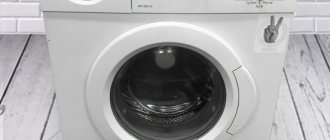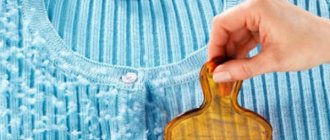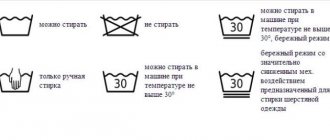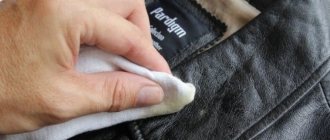Inattention or ignorance of this rule can cause some things to completely lose their appearance after cleaning.
What does the machine wash prohibited icon on a clothing label mean and what it looks like, we will tell you further.
What are they for?
When purchasing outfits, most people do not look at the manufacturer's care recommendations. But in vain. For example, how are you going to clean a coat that only requires dry cleaning if you live in a small village where there are no such establishments? If you don't follow the rules, the item will quickly lose its attractiveness.
For good appearance and long service life, textiles must be washed with a suitable washing powder.
The symbols that are applied to the label are universal and are adopted in many countries at the legislative level. Therefore, they are mandatory in textile factories.
The label itself is a piece of fabric sewn to the product in an inconspicuous place on the reverse side. In addition to information on how to wash, it most often provides information about the manufacturer and composition of the fabric.
Many people cut off these tips because the tag can be uncomfortable to wear. In this case, it is better to save the label and return to the care instructions as needed.
To avoid turning your home into a warehouse of cut-off labels and to avoid getting confused about which item belongs to which, use this simple advice. Before cutting off the tag, take a photo of it together with the item, and it will be clear which dress or sweater it is sewn on. And when you need information, just find the photo you need in the memory of your phone or camera.
In the following sections we will get acquainted with the symbols that appear on the tags.
Special care icons in pictures - photo gallery
The symbols on the label recommend drying the product only.
It is recommended to handle down jackets with care; down is very capricious. This also applies to duvets.
Leave the care of your favorite fur coat to the professionals. Sheepskin coats are recommended to be dried at low temperatures
Sometimes manufacturers sew not informative, but funny labels onto things. Just watch and enjoy.
Basin - washing
The washing parameters are regulated mainly by the pictogram, which shows a basin (1). Its presence indicates that the product is washable.
- The crossed out container (2) indicates that the item of clothing cannot be washed: it should only be dry cleaned.
- If you see a basin highlighted with a horizontal line from below, then know that such a thing must be handled carefully, accurately maintaining the temperature, not subjected to strong mechanical stress and wrung out at minimum speed. The double line (3) indicates that cleansing should be as gentle as possible: with plenty of water and a quick rinse.
- In the picture you can see the numerical designations 95, 60, 30 (4) - they show the intensity of water heating allowed for this material.
- The points (from one to three) (5) are analogous to the previous value and are also responsible for adjusting the temperature - the more points, the hotter the water can be used.
- A hand lowered into the basin (6) means that the outfit can only be washed by hand.
- A twisted tourniquet (7) indicates that it is contraindicated to twist or wring out the item.
Italian program names
Original equipment from the brands Indesit, Ardo, Ariston can surprise you with Italian font:
- Marchia/Arresto - on/off;
- Ammollo - soaking;
- Asciugatura - drying;
- Base - basic;
- Centrifuga - spin;
- Esclusione - cancellation;
- Facile stiratura (Stira meno) - light ironing;
- Forte lavaggio - intense;
- Giri - number of revolutions;
- Lavaggio a mano - manual;
- Delicato - delicate;
- Lavaggio rapido - fast, express;
- Pre-lavaggio - preliminary;
- Risciacqui - rinsing;
- Ritardatore di partenza - delay, postponement;
- Speciale - special, special;
- Trattamenti - rinse with conditioner-rinse aid.
Square – spinning and drying
The most incomprehensible meanings for me are the various squares. They have many types, and therefore remembering them is not so easy. In general, the square (1) always means spin and dry mode.
- A crossed out square (2) usually complements the “Do not wash” sign and indicates that the product should not come into contact with water.
- If there is a horizontal line (3) in the center, then only horizontal drying is shown. When there are two stripes, this means that the product cannot be wrung out.
- One vertical line in the square (4) determines that the clothes can be placed on a rope or hanger. Two vertical lines indicate that the product should be dried without squeezing.
- You can find the same signs as the four described above, but in the left corner they have diagonal lines (5). All the rules are valid for them, as for standard images, however, in addition to this, you should not place such outfits in direct sunlight.
The next group of indicators is a square with a circle drawn inside it (6). This marking indicates that the item can be dried in a machine.
- One, two or three dots (7) can be depicted in the center of the circle. They regulate the permitted drying temperature, where three dots indicate the highest values allowed.
- Under the image that can be processed in a machine, you can see a horizontal line (8) - evidence that the procedure should be gentle. If there are two such stripes, then it is recommended to use only the delicate mode.
- If the symbol is crossed out (9), then the machine procedure is strictly prohibited.
They are not used now, but you can still find other signs on old clothes.
- A square with an arc running from one top corner to the other (10) - this outfit can be dried vertically.
- In the corner of the rectangle there are three diagonal lines (11). They say that the item needs to be protected from direct sunlight and dried in the shade.
- A square with three vertical lines (12) means that it is better not to spin the item.
The best means
To make the process as comfortable as possible for capricious fabrics, you need to choose the right detergents:
- They should be easily soluble. Easy to rinse off. That is why it is recommended to use not a powder, but a gel or liquid product.
- Aggressive substances should not be in their composition.
- Do not affect the color of fabrics.
- Smells nice.
- Have a softening effect.
Circle – dry cleaning
Circle (1) will tell you about the conditions of dry cleaning in specialized enterprises. There are pictures for regular “dry” cleaning.
- The crossed out circle (2) indicates that dry cleaning is prohibited.
- The letter A (3) indicates that treatment with any solvent is possible.
- The P icon in a circle (4) indicates that the procedure can be carried out with ethylene chloride, hydrocarbon, monofluorotrichloromethane.
- Underlined circle with the letter P (5) – the remedies from the previous version are valid, but the procedure itself is more gentle.
- Symbol F (6) allows the use of trifluorochloromethane and hydrocarbons.
- If the circle with F is underlined (7), then it is permissible to use the means described above, but in a delicate mode.
In addition to “dry” there is also “wet cleaning”. It has its own indicators, and the main one, which determines whether it is permissible to clean an object in this way, is a circle with the letter W (1):
- If the pictogram is crossed out (2), then water cleaning is impossible.
- When there is one horizontal line (3) under the symbol, you know that you need a delicate mode.
- A double underline (4) indicates the need for particularly careful procedure.
Nuances that are important to know
Surely, you are interested in the question - what washing conditions should be followed in order for the delicate mode to wash truly delicately, but effectively? There are few rules:
- separate colored items from light ones;
- for washing it is better to use a specialized liquid detergent and a small amount of softener;
- Pre-soak heavy stains with stain remover for delicate fabrics;
- refrain from pre-soaking;
- some things, such as linen, should be loaded into the washing machine only in special covers or bags;
- do not leave things in the machine after finishing washing;
- Some things that are prone to stretching are best not hung, but rather laid out to dry.
Triangle – whitening
A similar pictogram (1) will tell you whether this fabric can be bleached and what methods are acceptable.
- A crossed out triangle (2) indicates that bleaching is not permitted.
- A figure containing two parallel oblique lines (3) means that only oxygen-containing and non-chlorine bleaches can be used.
- If you see the letters CL (4) in the center of the triangle, this indicates that it is acceptable to add products containing chlorine.
How does SMA erase in delicate mode?
The principle of the program, regardless of the name, is the same in all SMAs:
- Much water. The tank is as full as possible. The abundance of water reduces the mutual friction of products - they wear out less. This also improves rinsing of detergents.
- Low water temperature.
- Slow rotation of the drum. Low speed prevents increased wear of linen, preserves accessories - rhinestones, beads, etc.
- Spin at low speeds or completely absent. Range - 600–800 rpm. If the SMA has mechanical control, then the spin option is installed additionally.
- Drum is not fully loaded. Usually 1.5–2.5 kg.
Be sure to put things in a bag or net - this is another measure to protect against wear and loss of accessories. If any small object falls off and falls down, the machine may even break.
Iron - ironing
This sign is the easiest to recognize because its symbol is a diagrammatic iron (1).
- If the iron is crossed out (2), then ironing of the item is strictly prohibited.
- Inside the symbol you can see dots (3), which determine the temperature allowed for ironing the material. One point – delicate mode up to 110 degrees Celsius, two – up to 150, three – up to 200.
- When the appliance has two lines at the bottom, diverging in different directions (which indicates steam) and they are crossed out (4), the outfit cannot be steamed.
How to turn it on?
It happens that the control panel does not have the necessary inscription - how can you install a gentle program in this case? Look for similar names - check the instructions, you need options that match the type of matter or temperature up to 40 degrees. Select the desired option using the selector switch or button - as provided in your machine, and press "start".
The program for delicate fabrics may have different names, but its essence is the same - a gentle approach to washing. The name may differ for different brands and models, but this does not prevent the user from finding the desired option. Any gentle regime is different:
- slow rotation of the drum;
- low water temperature.
Letter marking
In addition to the icons, the label contains short warning and prohibition notices in English. I present the most common of them.
- Machine wash – machine washable.
- Hand wash only – hand wash only.
- Wash separately - process separately from other materials due to the possibility of coloring.
- No wash / Do not wash – do not wash, use dry cleaning only.
- Do not dry clean - dry cleaning is prohibited.
- Do not bleach - do not bleach.
- Do not tumble dry - do not tumble dry.
- Do not wring or twist - do not squeeze or twist.
- Dry in shade – hang only in the shade.
- Do not iron - do not iron.
For more information about decoding the icons, watch the video.
Force you to work overtime, on weekends or at night
Transfer the employee to the night shift, force him to stay late, schedule inventory for the weekend. You agree not to ask for consent, not to pay extra for processing.
The employee is required to be at work during the hours specified in the employment contract and labor regulations. Working hours should not exceed 40 hours per week - Art. 91 Labor Code of the Russian Federation.
To work beyond the norm, written consent is taken from the employee and added to the salary.
Overtime is working after a shift, working an extra shift, or working on a weekend. Duration is limited: no more than 4 hours per two weeks and 120 hours per year. The rule is from Art. 99 Labor Code of the Russian Federation.
Recycling itself is not prohibited. But there must be a goal: unload perishable food, replace a barista who is absent, repair a broken pipe. Pregnant women and minors cannot be involved in additional work. And disabled people and mothers of children under three years old can refuse.
They pay extra for overtime work. In the first two hours - one and a half times more, in the subsequent hours - twice as much. Instead of additional payment, the employee can choose a day off - Art. 152 Labor Code of the Russian Federation.
At night they work from 22 to 6 o'clock. The night shift is one hour shorter than the day shift. For a one-time night out, written consent is taken from the employee. To completely transfer an employee to night mode, an additional agreement is drawn up to the employment contract. Details - in Art. 96 Labor Code of the Russian Federation.
Often it is written into the employment contract that the working hours are irregular. This means that an employee can sometimes be left behind after a shift and required to go on a day off. There is no need to take written consent. The amount of additional hours is recorded in the employment contract.
If processing falls on a weekend or holiday, the payment is doubled. Or, at the request of the employee, the bonus is replaced with an extra day off. Rules from Art. 153 Labor Code of the Russian Federation.
Signs of modern times
Nowadays, an explanation has also appeared why it is better not to take out the trash in the evening. For example, in the evenings there are suspicious people hanging around in the yard, and meeting them does not bode well. It is safe to take out trash in residential areas during the day.
A completely everyday and banal reason - in many entrances the light bulbs are broken, and in the evening you can slip in the dark or twist your ankle. There is also not always lighting near houses - you can get your shoes dirty in the mud.
After sunset, stray dogs gather around trash cans. This meeting can end in disaster if any dog suffers from rabies or simply decides to attack.
Women do not allow their husbands to take out the trash can in the evenings because of the temptation to have a drink with a neighbor or get into the company of friends who have been playing around. In addition, in the evening it is easy to catch a cold, the treatment of which will be expensive.
Some common signs about garbage
Mixing household and food waste means losses. This sign has ancient roots, since cattle used to be fed waste from the owners’ table. If food waste was mixed with household items, feed had to be purchased separately for livestock.
When changing homes, they took the rubbish with them. This sign is relevant for those whose life in the old place was fine. If they wanted to get rid of problems, they threw out all the garbage at their previous place of residence.
However, they did this while observing precautions: so that things would not be damaged by neighbors or ill-wishers
Garbage was not taken out on church holidays and Sundays, so as not to upset the holy powers. Our ancestors did all the housework on weekdays, and Sundays were dedicated to prayers and visiting temple.
According to folk superstitions
Popular superstitions are quite strict about everything that relates to the house and the things in it. Garbage is no exception.
According to legends, there are several reasons why it is undesirable to take out waste after sunset:
- It is believed that when the daylight sets beyond the horizon, dark spirits become very active and can cling to a person’s personal belongings that he has taken outside.
- Good forces are also activated at night and protect the house from evil. If a person takes something out of his home, dark and light spirits may collide with each other. The result of such a clash is often that the forces of good leave the house, and demons take up residence there instead.
- If a man takes out the trash in the evening, he may lose his virility and have problems of a sexual nature.
- If a woman or girl does this, then she risks losing her beauty.
- Such an act brings poverty to the family, since all resources will literally flow away in an unknown direction.
- The sign is especially strict for expectant mothers; if it is violated, there is a risk of losing the baby.
- If a person nevertheless decides to violate the order, and garbage accidentally scatters along the road, this foreshadows the imminent death of a loved one or a serious illness.
In a modern interpretation
From the point of view of a person of the 21st century, getting rid of trash after dark is highly undesirable, because at this time it may be unsafe on the street. Homeless people or stray dogs often hang around trash cans. If the street is poorly lit, there is a risk of tripping and getting injured or meeting criminals and becoming a victim of an attack. The best option is to throw out the trash bag in the morning on your way to work.
If a person adheres to the rules of Feng Shui, then the ban will be relevant in this case too. The postulates of Eastern teachings say that you should not get rid of trash at night. According to the rules of this ancient science, new, fresh energy takes the place of discarded things.
Feng Shui
The Chinese teaching of Feng Shui also negatively interprets the habit of taking trash out of the house after sunset. This step is believed to disrupt the normal flow of Qi energy. Together with household waste in the evening, a person takes away good luck and wealth from his home.
What happens if you don’t wash clothes from a store after purchasing them?
Dermatologists say that all chemical compounds used in the production of clothing can cause allergies, irritation and rashes on the skin.
Many countries have restrictions on the use of formaldehyde in fabric processing, but not everyone adheres to this.
To make things white, textiles are soaked in bleach or hydrogen peroxide. If you wear bleached clothing without first washing it, there is a risk of irritation and severe contact dermatitis.
Purchased textiles may contain various bacteria and respiratory secretions from other people who tried them on before you purchased the new item. Contact with germs increases the risk of contracting various types of infections.











